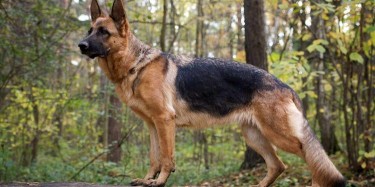
The German Shepherd is a medium to large dog breed known for their intelligence, loyalty, and protective instincts. They are often used as working dogs in a variety of roles, including police dogs, search and rescue dogs and service dogs. They are also family pets, but they require a lot of exercise and training.
With a strong body, erect ears and an alert expression, German Shepherds stand out as symbols of royalty and dedications. This remarkable breed makes cherished family pets. They are known for their protective instincts, affectionate nature, and boundless energy, great in loyalty and loving companion to those who appreciate their remarkable blend of intelligence and devotion.
These traits are related on a scale of 1-5 with 1 being the least and 5 being the highest. Remember dogs are individuals, and not all dogs, even those with the same breed, won’t exhibit same qualities
When considering a German Shepherd, it’s advisable to prioritize adopting from rescue organizations or shelters to provide a loving home to a dog in need. Conduct a thorough research to ensure that the breeder follows ethical practices and prioritize the well-being of their dogs, when it comes to their health, and temperature.
When it comes to German Shepherd puppies conduct necessary health screenings, and provide a nurturing environment for them. This active approach ensures that you bring home a healthy and happy pup while discouraging unethical breeding practices.
QUICK FACTS
1. Ears: German Shepherds are born with soft, floppy ears. Their ears open toward the front and are particularly erect when the German shepherd stands at attentions.
2. Eyes: German Shepherd eyes are dark and almond-shaped with an intelligent and eager expression.
3. Nose: they typically have a predominantly black, square nose and a long, straight muzzle.
4. Height: Adult males are usually 24-26 inches while female are 22-24 inches.
5. Coat color: Their coat colors varies wildly it include black and cream, black and tan, black and red, black and silver, they can always be sable, gray, blue, or liver, though these colors are considered faults by the AKC.
6. Tail: They have a long bushy tail with a slight hook like a saber.
7. Weight: Male are usually 65-90lbs while female are 50-70lbs
8. Coat Length: Most German shepherd have a medium-length double coat. The outer coat is typically dense and straight, but some may be slightly wavy.
9. Life span: 9 to 13 years
10. Temperature: Their temperature is characterized by loyalty, determination, and intelligence.
GERMAN SHEPHERD (PERSONALITY)
This breed’s personality is characterized by a suitable aloofness rather than overt aggression. These dogs are inclined toward reserve, forming connections, they don’t connect instantly but when they do they it go’s deeply, and once those bond are formed, their loyalty knows no bounds. Within their family cycle they exhibit an affable and approachable demeanor, when faced with threats, they instantly transform into stalwart protectors, showcasing their exceptional watchdog abilities.
German shepherd are endowed with remarkable intelligence and trainable instincts, they thrive when given a purposeful task no challenge is too great. From alerting a hearing-impaired individual to a doorbell’s chime to locating a victim buried under an avalanche.
A German Shepherd left under stimulated and isolated from family activities may resort to undesirable behaviors, such as excessive barking and destructive chewing. Without the necessary interaction, exercise and opportunities to engage their sharp minds, they may experience boredom and restlessness.
GERMAN SHEPHERD (HEALTH)
Good health is typically what German Shepherd enjoys, they have susceptibility to specific health conditions. Not every German Shepherd will experience these ailments, its vital to familiarize yourself with potential issues if you’re contemplating on adopting this breed.
• Elbow Dysplasia: They is primarily found in large breeds, this heritable condition results from differential growth rates among the elbow’s three constituent bones, causing joint instability, which causes painful lameness. Veterinary recommendations could encompass surgical intervention or prescribe medications for pain management.
• Bloat (Gastric Dilatation-Volvulus): Bloat occurs when the stomach distends due to gas or air and subsequently twists. This life threatening situation predominantly affects deep-chested large dogs. Suspect bloating if your dog exhibits abdominal distention, excessive salivation, retching without vomiting, restlessness, lethargy, and rapid heart rate. Immediate medical attention is crucial to prevent shock and possible fatality.
• Allergies: They are susceptible to various allergies encompassing contact and food sensitivities. Indication may involve paw licking, persistent scratching, and facial rubbing. Consult your vet if you notice such symptoms.
• Exocrine Pancreatic Insufficiency: This is a genetic pancreatic disorder that diminishes digestive enzyme production, leading to impaired food digestion and absorption. Symptoms are: gas, appetite loss, weight reduction, altered stools, and increased hunger. Diagnosis are carried out through blood test, while treatment involves adding pancreatic enzymes to the dog’s food.
• Hip Dysplasia: Hip dysplasia can manifest without or sometimes with apparent symptoms. This hereditary concern entails the improper fitting of the femur into the hip joints pelvic socket. May dogs may display lameness and discomfort in one or both hind legs, with arthritis potentially developing as they age. Dogs with hip dysplasia should not be used for breeding.